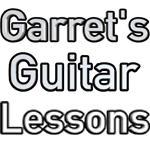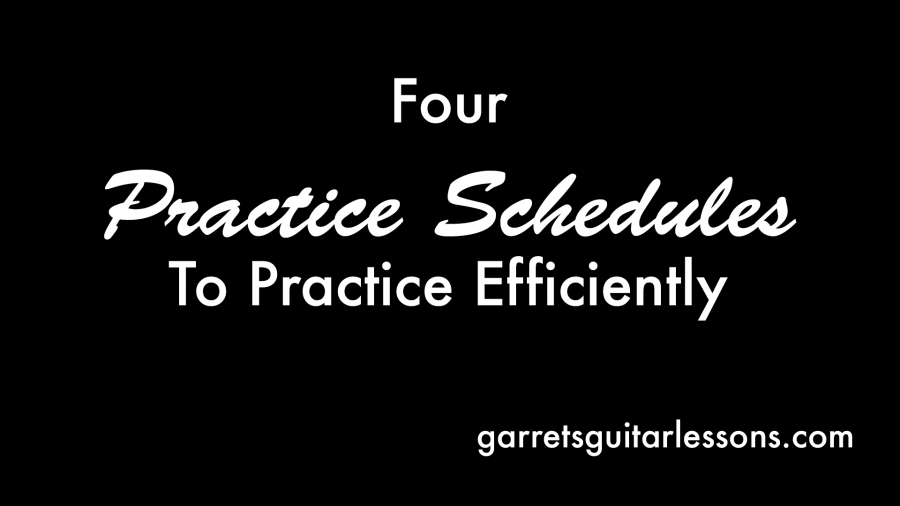Alright I’m just going to give you a practice schedule. You can alter this depending on where your at and where you want to work on. Essentially I’m going to give you 4 days worth of practice, giving you specific things to focus on each day: A = Chords, B = Scales, C = Arpeggios, D = 7th Chords. There’s so much under each category, that I’m hoping this is a schedule that you can grow with. It’s not very realistic to practice each one of these things in the suggested time frame, so pick one or two, but most importantly, change your routine every day. The goal is that over time things will sink in.
I have this available below as a PDF download, and even have a “Practice Tracker” PDF too. Write down the time you practiced, the routine you practiced and switch it up each day. I also mention “Key of the Day”. Key of the Day: What I would do is run through the circle of 4ths every time you practice. Start on C then follow the Circle of Fourths: (C-F-Bb-Eb-Ab-Db-F#-B-E-A-D-G) for each following day. Example: On Monday, use the key of C. On Tuesday, use the key of F. On Wednesday, use the key of Bb.
20% of time | 30 minutes = 6 minutes | 45 minutes = 9 | 60 minutes = 12
40% of time | 30 minutes = 12 minutes | 45 = 18 minutes | 60 Minutes = 24 minutes
*First number “30 minutes” would mean your allotted practice time. Second number would be what that percentage means for your actual practice. Example: You have 30 minutes to practice, you practice “Finger Exercises” for 6 minutes.
**15 Minutes, Just practice one of the 40% topics.
Practice Routine A
Chords
Finger Exercises/Diminished Chord Runs | 20% of Time
– Number Finger Exercises
Different Combinations of 1-2-3-4
1) Do one combination ascending spanning 7 frets
2) Do another combination descending spanning 7 frets
3) After you’re comfortable with that try a whole sequence (1-2-3-4, 1-2-4-3, 1-3-2-4, 1-3-4-2, 1-4-2-3, 1-4-3-2) spanning the 6 frets.
– Diminished Chord Runs
– Bends – 3 Areas of Neck (5th Fret – 10th Fret – 15th Fret)
Each finger, going up a whole step.
Ascending = Bending, hearing the tones in between.
Descending = Pre-Bending, sounds the same as hitting different frets, no tones in between.
New Stuff | 40% of Time
– Major and Minor Chords
CAGED Chords (Major and Minor)
Triads (4 different string sets: 1-3, 2-4, 3-5, 4-6)
Wide Interval Triads
Inversions
Put them in common chord progressions, in different areas of the neck
Analyzing stuff you know | 40% of Time
– Songs You Know How To Play/Songs You Like
Take some time one day, and write out a list of songs you want to analyze, it’s a bit of back-end work, but will pay off when it comes to practice. Start a list on your phone, look at your set… whatever’s clever just don’t think “I’ll do that the day of”. Put it in a random order.
What are the Chords As Numbers?
Play it in a different key (Key of the Day)
Use some of the new chord shapes
Play it using major and minor chord shapes that aren’t your “go-to”
Practice Routine B
Scales
Scale Runs/Bends/Finger Exercise Chord Runs | 20% of Time
– Scale Runs
Two different ways depending on the week (Circle Of Fourths & Throughout the Whole Neck)
Major and Minor Scales (Ionian and Aeolian)
Major and Minor Pentatonic
Always start and end on the root note
Key of the Day
– Finger Exercise Chord Runs
Finger to a string. Similar to the combinations above, just now with chords
– Bends – 3 Areas of Neck (5th Fret – 10th Fret – 15th Fret)
Each finger, going up a half step.
Ascending = Bending, hearing the tones in between.
Descending = Pre-Bending, sounds the same as hitting different frets, no tones in between.
New Stuff | 40% of Time
– Different Scales/Modes
Dorian Scale
Mixolydian Scale
Harmonic Minor Scale
Lydian Scale
Phrygian Scale
Lydian Dominant Scale
– Horizontal Scales
One String (Major/Minor/Pentatonics/Modes)
Two Strings (Major/Minor/Pentatonics/Modes)
Three Strings (Major/Minor/Pentatonics/Modes)
**Order I put things are how common they are… roughly.
Using Backing Tracks to Let Stuff Sink In | 40% of Time
Take a Backing Track That’s Relevant to the “New Stuff” You Practiced. & Major/Minor
Key of the Day
Set Limits for Yourself
Allow yourself to only use a certain number of strings
Allow yourself to only stay in a certain position
Build phrases
Limit your rhythms you can use (8th notes or a rhythm linked) but still allow pauses for phrases
Sing something and play it
What beat your start on/what chord you start on
Practice Routine C
Arpeggios
Arpeggio Runs/CAGED Chord Runs/Bends | 20% of Time
– Arpeggio Runs
Two different ways depending on the week
Major and Minor Arpeggios
Always start and end on the root note
Key of the Day
– CAGED Chord Runs
Key of the Day
Only up and down the neck – Major & Minor CAGED Chord Shapes
– Bends – 3 Areas of Neck (5th Fret – 10th Fret – 15th Fret)
Each finger, going up a whole step.
Ascending = Bending, hearing the tones in between.
Descending = Pre-Bending, sounds the same as hitting different frets, no tones in between.
Transcribing | 40% of Time
– Take the Same List You Made Above and Learn the Chords/Melody/Solo
– Learn It (or Part Of It) By Ear
How does the melody compare to the chords underneath?
Do the chords fit within a key? If not, what’s a good way to analyze/solo?
Transpose to Key of the Day
– Take a Lick You Learn and Change It to Be Your Own
Change the first note
Change the last note
Change the rhythm
Metronome Only | 40% of Time
– Put a Metronome On Each Quarter Note (1 2 3 4)
Strum song/chord progression (good way to try new chords from A)
Practice scales (good way to try new scales from B)
Solo using only (well… mainly) arpeggios of a chord progression/song
– Put a Metronome on Each Snare Hit ([1] 2 [3] 4)
Strum song/chord progression (good way to try new chords from A)
Practice scales (good way to try new scales from B)
Solo using only (well… mainly) arpeggios of a chord progression/song
Practice Schedule D
Extended Chords & Arpeggios
7th Arpeggio Runs/Inversion Chord Runs/Bends | 20% of Time
– 7th Arpeggio Runs
Two different ways depending on the week (Circle of Fourths or Ascending and Descending the Neck)
Major 7, Dominant 7, Minor 7, Minor 7 Flat 5, Diminished
Always start and end on the root note
Key of the Day
– 7th Inversion Chord Runs
Key of the Day
Only up and down the neck
– Bends – 3 Areas of Neck (5th Fret – 10th Fret – 15th Fret)
Each finger, going up a half step.
Ascending = Bending, hearing the tones in between
Descending = Pre-Bending, sounds the same as hitting different frets, no tones in between.
New Stuff | 40% of Time
– Major 7 Inversions/Arpeggios
– Dominant 7 Inversions/Arpeggios
– Minor 7 Inversions/Arpeggios
– Minor 7 Flat 5 Inversions/Arpeggios
– Diminished Arpeggios
– extended chords
Analyze and Practice Jazz Charts/Read Classical | 40% of Time
– Take a Jazz Chart and Pick One at Random
If the Whole Thing Looks Intimidating Take the First 8 bars the First Day, the Second the Second Day or Any Section of It.
What are the tonal centers?
How would you play the chords?
What arpeggios/scales would be appropriate?
Can you substitute the chords with inversions/extended chords?
Make a loop/video of you playing the chords. Take it slow and try to play pieces of the right arpeggio/scale.
Find versions of the scale/arpeggio that are close
– Take a Jazz Chart, Learn the Melody
– Take a Classical Chart and Read Through It
The reading isn’t to play it performance ready, just to think about tonal centers and/or keeping your reading chops from disappearing.

